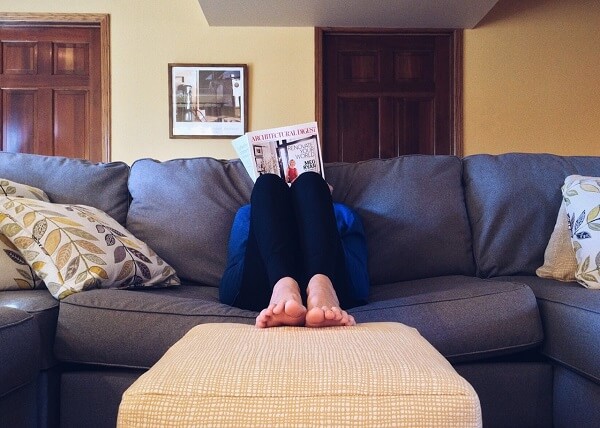Secret Thoughts Interior Designers Have About Your Home – Revealed
Whether you are looking to turn your home into a contemporary living space worthy of your friends’ and relatives’ admiration or preparing to put your home on the market to attract more of the best quality buyers, then you should get the input of an interior designer – and an honest one at that!
Experienced interior designers blend natural good taste with a finger on the pulse of fashion. Ignore their advice at your peril!
For this article, we have exposed some of the secret thoughts tactful interior designers tend to keep to themselves when casting their eyes around people’s properties.

“Nice blank wall you have there.”
An interior designer sees things consciously that mere mortals are only aware of on a subconscious level. For example, a would-be buyer may feel a sense of boredom as they walk around your home but not know why.
A designer may notice that you have placed artwork a little too high and ended up framing the boring blank wall beneath. Simply by moving art pieces to around three to eight inches above furniture level (large pieces should be hung lower than smaller pieces) that wonderful Monet collection suddenly springs into view. Hey presto, you may have inspired a sale.
“This room looks…lived in.”
We tell ourselves that a bit of clutter left lying around is a sign that our home is friendly and lived in. To a would-be buyer, the situation screams of a storage issue – even if you have plenty of cabinets and shelves but just chosen not to fill them.
The solution? Always present a tidy home to potential viewers. If you are unable to because of a lack of places to put things, a designer will almost always be able to point out areas of vertical and horizontal space that you could be using more effectively.
“Are you a vampire – or just allergic to light?”
Light has a huge effect on the ambiance of a room and nothing sucks the fun and life out of a space than masses of dark brown furniture, dark-colored walls, and thick, heavy curtains.
Sure, there is a place for dark tones in balancing a room, but there is a difference between feeling grounded and feeling chained to the floor! Replace dark curtains with light drapes and mahogany pieces with those made from blond wood. Fix a large mirror opposite the window. These steps will immediately make the room seem a larger and more inspiring space.

“Where do I start with the un-decorating?”
You wouldn’t dream of giving an artist a used piece of paper and an eraser when asking for a portrait but that is what you are doing if you advertise a home with too much of ‘you’ in it. It is commonly understood that around sixty percent of a room should be painted in one main color but if you choose a bold red or blue and your prospective buyer dislikes it you have just given them an unwanted job to do.
Most people can live with neutral colors and will see them as a blank canvas from which to design their space to their own taste. To inject your own personality, think more about accent colors and pieces as these will not be seen as a barrier to a sale.
“What exactly do you love about that wall?”
To a designer, a wall either serves a purpose or is in the way. And holding your roof up does not usually count as a purpose since RSJ beams can take the place of almost any supporting wall.
Removing walls is another way to introduce space and light into a room and doesn’t have to cost the Earth. So be willing to open your mind to all the possibilities.

“Is this a room or an aircraft hangar?”
There’s a difference between an open plan room and a design wasteland. Huge empty spaces can feel very unwelcoming and disorientating but this can be easily overcome with some clever design tweaks.
Large rugs are an amazing way of dividing rooms into different zones. Furniture should be placed fully onto rugs of 8×10 inches or larger. For smaller rugs, place only the front legs of chairs and tables to avoid cramping the space.
“That furniture really is wasted on you.”
If you think that an experienced interior designer is going to be excited by high-end sofa brands or Chippendale antique bookshelves then think again. It’s not that they don’t appreciate the quality, it’s just they’ve seen it all before.
They will be more interested in how you showcase your quality furniture. For example, is your sofa adorned with identical square cushions? How about switching some for circular or rectangle alternatives with different patterns based on the room’s colour scheme. Are your books standing next to one another organized by an author? Try placing some horizontally and using size and colour to guide your layout.
Likewise, an eye for design can transform even the most commonplace items into works of art as the famous fake Arne Jacobsen chair in this photograph illustrates!
The above tips should help you present your room in its best light, but the best tip of all is to invite an interior designer to your home and ask them to give you a no-holds-barred appraisal.
About the Author:
 Ronnie Stone is a home decor and DIY geek, HGTV addict, writer, and blogger. He’s currently writing for https://www.octaneseating.com the industry’s number one source for quality products, competitive prices, and knowledgeable service. Twitter @OctaneSeating
Ronnie Stone is a home decor and DIY geek, HGTV addict, writer, and blogger. He’s currently writing for https://www.octaneseating.com the industry’s number one source for quality products, competitive prices, and knowledgeable service. Twitter @OctaneSeating



